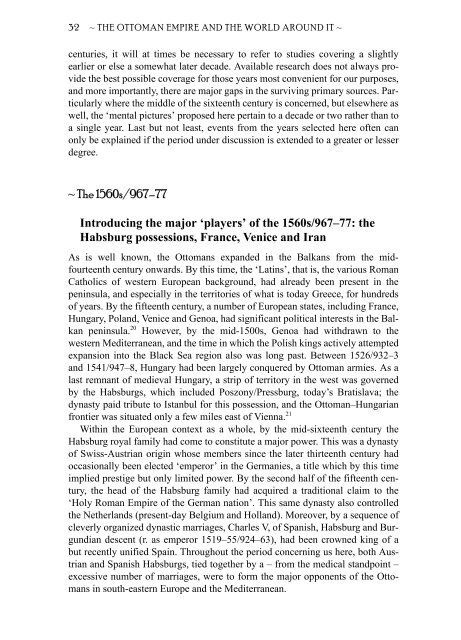The Ottoman Empire and the World Around It - Course Information
The Ottoman Empire and the World Around It - Course Information
The Ottoman Empire and the World Around It - Course Information
You also want an ePaper? Increase the reach of your titles
YUMPU automatically turns print PDFs into web optimized ePapers that Google loves.
32 ~ THE OTTOMAN EMPIRE AND THE WORLD AROUND IT ~<br />
centuries, it will at times be necessary to refer to studies covering a slightly<br />
earlier or else a somewhat later decade. Available research does not always provide<br />
<strong>the</strong> best possible coverage for those years most convenient for our purposes,<br />
<strong>and</strong> more importantly, <strong>the</strong>re are major gaps in <strong>the</strong> surviving primary sources. Particularly<br />
where <strong>the</strong> middle of <strong>the</strong> sixteenth century is concerned, but elsewhere as<br />
well, <strong>the</strong> ‘mental pictures’ proposed here pertain to a decade or two ra<strong>the</strong>r than to<br />
a single year. Last but not least, events from <strong>the</strong> years selected here often can<br />
only be explained if <strong>the</strong> period under discussion is extended to a greater or lesser<br />
degree.<br />
~ <strong>The</strong> 1560s/967–77<br />
Introducing <strong>the</strong> major ‘players’ of <strong>the</strong> 1560s/967–77: <strong>the</strong><br />
Habsburg possessions, France, Venice <strong>and</strong> Iran<br />
As is well known, <strong>the</strong> <strong>Ottoman</strong>s exp<strong>and</strong>ed in <strong>the</strong> Balkans from <strong>the</strong> midfourteenth<br />
century onwards. By this time, <strong>the</strong> ‘Latins’, that is, <strong>the</strong> various Roman<br />
Catholics of western European background, had already been present in <strong>the</strong><br />
peninsula, <strong>and</strong> especially in <strong>the</strong> territories of what is today Greece, for hundreds<br />
of years. By <strong>the</strong> fifteenth century, a number of European states, including France,<br />
Hungary, Pol<strong>and</strong>, Venice <strong>and</strong> Genoa, had significant political interests in <strong>the</strong> Balkan<br />
peninsula. 20 However, by <strong>the</strong> mid-1500s, Genoa had withdrawn to <strong>the</strong><br />
western Mediterranean, <strong>and</strong> <strong>the</strong> time in which <strong>the</strong> Polish kings actively attempted<br />
expansion into <strong>the</strong> Black Sea region also was long past. Between 1526/932–3<br />
<strong>and</strong> 1541/947–8, Hungary had been largely conquered by <strong>Ottoman</strong> armies. As a<br />
last remnant of medieval Hungary, a strip of territory in <strong>the</strong> west was governed<br />
by <strong>the</strong> Habsburgs, which included Poszony/Pressburg, today’s Bratislava; <strong>the</strong><br />
dynasty paid tribute to Istanbul for this possession, <strong>and</strong> <strong>the</strong> <strong>Ottoman</strong>–Hungarian<br />
frontier was situated only a few miles east of Vienna. 21<br />
Within <strong>the</strong> European context as a whole, by <strong>the</strong> mid-sixteenth century <strong>the</strong><br />
Habsburg royal family had come to constitute a major power. This was a dynasty<br />
of Swiss-Austrian origin whose members since <strong>the</strong> later thirteenth century had<br />
occasionally been elected ‘emperor’ in <strong>the</strong> Germanies, a title which by this time<br />
implied prestige but only limited power. By <strong>the</strong> second half of <strong>the</strong> fifteenth century,<br />
<strong>the</strong> head of <strong>the</strong> Habsburg family had acquired a traditional claim to <strong>the</strong><br />
‘Holy Roman <strong>Empire</strong> of <strong>the</strong> German nation’. This same dynasty also controlled<br />
<strong>the</strong> Ne<strong>the</strong>rl<strong>and</strong>s (present-day Belgium <strong>and</strong> Holl<strong>and</strong>). Moreover, by a sequence of<br />
cleverly organized dynastic marriages, Charles V, of Spanish, Habsburg <strong>and</strong> Burgundian<br />
descent (r. as emperor 1519–55/924–63), had been crowned king of a<br />
but recently unified Spain. Throughout <strong>the</strong> period concerning us here, both Austrian<br />
<strong>and</strong> Spanish Habsburgs, tied toge<strong>the</strong>r by a – from <strong>the</strong> medical st<strong>and</strong>point –<br />
excessive number of marriages, were to form <strong>the</strong> major opponents of <strong>the</strong> <strong>Ottoman</strong>s<br />
in south-eastern Europe <strong>and</strong> <strong>the</strong> Mediterranean.


